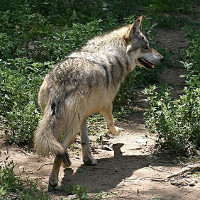Until the 1900s, the Mexican gray wolf roamed central Mexico, Arizona, New Mexico and western Texas. Settlers at that time began hunting the wolf's prey, forcing the wolf to turn its attention to the settler's livestock. This led the settlers to hunt the wolf.
In the 1950s, the Mexican wolf was virtually wiped out in the USA by private trappers and government agencies. The last known wild Mexican wolf in the USA was shot in 1970. In 1976, they were listed as endangered. Their numbers have since been increased through captive breeding, and they have been released into the wild, although they are still a very rare mammal in the wild.
In the wild, wolves feed mainly on deer, antelope, rabbits and other small rodents. As the smallest subspecies of gray wolf, the Mexican gray wolf varies in size from 1.27 to 1.62 m in length (nose to tail), 61 to 81 cm in shoulder height, and weighs from 22 to 41 kg. Its coat is generally a mixture of black, Mexican gray wolf and gray. They live in packs, usually consisting of a breeding pair and their offspring. Like the Canis Lupus, all pack members help raise the young. |







 English (United Kingdom)
English (United Kingdom)